“How Do We Know?”
Issue #10, March 2020
TABLE OF CONTENTS
Lise Weil, Kristin Flyntz, Krista Hiser, Karen Malpede, Nancy Windheart, Kate Tirion, Hilary Giovale, Sara Wright
Editorial
Manulani Aluli Meyer
Ho’oulu: Our Time of Becoming (Foreword)
Lise Weil
Interview with Manulani Aluli Meyer (Video)
Dorothy Dinnerstein
with Karen Malpede, Naomi Miller and Sarah Karl
Sentience and Survival
Patricia Spears Jones
Flame
Lee Maracle
Nobody Home
Nancy Windheart
Aspen Ways of Knowing
Gillian Goslinga
Interview with Kate Tirion of the Deep Dirt Institute
Leonore Wilson
The Fire That Nearly Took Us
Hilary Giovale
The Blood Knows
Sara Wright
After•Word: “Born Again”
Richard Powers’ The Overstory
Gillian Goslinga
Interview with Kate Tirion of the Deep Dirt Institute and Campus
The pull of abstraction is so powerful in our culture that a majority of us live our lives inside landscapes of ideas and words and virtual bodies of knowledge.1 For Kate Tirion, Founder and Program Director of the Deep Dirt Institute and Campus, a permaculture teaching center in Patagonia, Arizona, retraining our minds and senses to know together with soil, plants, and fauna once again is a matter of urgency.
At Deep Dirt Institute you can feel this truth. Every time I have set eyes on Kate and visited the thirty-four acres of rolling grasslands that she and her partner Richard Connolly are loving back to life with the help of hundreds, a long-lost life force joyfully returns to light up every cell of my being. It’s a deep and wordless remembrance of what it’s like to breathe, sense, and partake of land that is truly well. Not thought to be well but deeply well, harmoniously partnered. Lise Weil, Dark Matter’s editor, whom I brought to the Institute last year, felt this same pull. She had to sit in meditation in the modest stone spiral amphitheatre at the heart of campus set amidst ingenious structures of reclaimed materials and adobe bricks made of Deep Dirt earth. The Institute’s motto “Restore the Land, Restore Ourselves” has lived permanently on my car’s bumper ever since my first visit, reminding me, and hopefully others pulled up in traffic behind me, that our well-being depends entirely on the well-being of the land.
Kate explains that her mission is to take the “and” out of “us and nature.” The reader will note that several times I trip up on this point as we talk, betraying the separation that still lives in me even as I completely agree with her... conceptually! The practice of discerning patterns and movement that are intrinsic to us and to the fabric of life, revealing our fundamental and marvelous unity, is an ongoing, visceral one for Kate. Keeping our knowing close to the ground is her invitation to us, one I hope more and more of us can and will heed.
December 28, 2019
Gillian Goslinga (GG): You’ve said that there is too much abstraction in knowledge at this time and that it is important for you at Deep Dirt Institute and Campus to make certain knowledges accessible concretely and immediately to people who come to you. You said this: “There is no time to delay in bringing people into this language.” I would love for you to unpack all that for us.
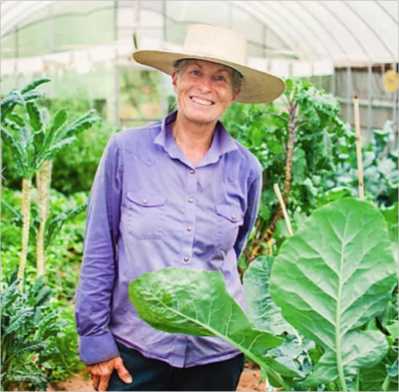 Kate Tirion and Happy Vegetables
Kate Tirion and Happy Vegetables
Kate Tirion (KT): Well, we are on a precipice and we have ten years to get off fossils. The entire civilization that we are currently living within is built on this fossil fuels world. Our food systems, our clothing, our technology, our communication, education— all of it. And we don’t know quite how we are going to move forward. We do know how to heal and repair things, but we are not set up to provide for our needs in our regions, in our communities by any stretch of the imagination. If you’d look at everything you have sitting around you that you depend on, and think about its journey, how it’s come to you, where it’s come from, how many hands have been part of it, and what part of the world, I think we’d all be pretty shocked by this. It’s not just about replacing what we have with a different kind of energy system. We have to rethink completely how we are living on the planet, from a consumption point of view and food point of view, from a water point of view, from weather that is coming at us that we have little to no control over. And so permaculture, which is the work that we do at Deep Dirt, is about the land—but it is also about our inner landscape, our community structures, our educational structures; it’s systemic thinking across the board. And what we’ve built at Deep Dirt Campus is a demonstration site for the restoration of the arid landscape—which is a third of the planet—and how we support that system in a way that it will build on itself over time, where we’ve become partners in its evolution. It’s this idea of relationship and reciprocity, giving to a place. When we do that it’s not just the land that heals. One of the things I want to do is to take the word “and” out of “us and nature”. Because we are not outside of it.
GG: Right, as per your sticker which I have on my car still, “Restore the Land, Restore Ourselves.”
KT: Yes, I found that when I was in the most difficult part of my life in my very early twenties, the soil is where I headed to for planting. But I didn’t know what to do. I was in a desert, very removed from anything that was familiar and the result was really reflective of my life at that time. Everything I planted died. But that was my life also. So … I’ve always turned to the soil, to the earth, to plants to anchor myself to find meaning, to find a place, but hadn’t always known what to do. Helping people find what to do feels important to me right now. Otherwise we will be frightened and when we are frightened we react and we are not so constructive. And I think that is why we are seeing so much opiate use; it’s because we are frightened. We are really scared.
GG: Yes. I’m wondering if you could concretize what you are saying with examples from your relationship to the land here. How do you come to know what you do, Kate? How does that conversation go?
KT: When you’re first addressing a place, it is about relationship-building. It begins with observation. For the first seven months of working with this particular site, I walked. I walked on it, I looked, I observed. I sat. I sat on the grass, in a tree. I went out at different times of the day, at different seasons of the year. I wanted to see the coldest day of the year, the longest and the darkest night of the year. Where did the sun rise in the morning, where did the sun set? And then at the extreme: the hottest, warmest, most abundant sunshine time of the year, what happened then? Where was the sun on the landscape, the shadows cast? And in the summer when it’s monsoon pattern, where does that rainwater move? Some of it is pretty obvious. The big movements are obvious because they always leave trails behind and you begin to understand what water flow looks like on the surface of the ground. And then there were more subtle ones. If you spend enough time in that relationship-building phase and the observation phase, you’ll notice things, you’ll notice animals that move through those landscapes, and birds, and the vegetation. You’ll start to notice what kinds of soils you’ve got and where they are. Because soils, although they may be somewhat uniform across the landscape, also have subtleties—there may be more sand over here, more clay over there, maybe rock here, and each one of those will function differently and perform differently.
All this knowledge, this observation becomes key when you’re thinking where might you put a building, where you want to grow food, where does the cold air move, where does it pool. What about fire? Where are the prevailing winds? Fire likes to create a little bit of its own weather in front of itself, it dries things out so they burn more readily. It likes to go up a hill where most of us like to build for the view, but that’s also the most precarious in terms of access and what roads do to landscapes—roads are hugely destructive. What if I’m parked on top of the hill in the wind and the fire comes along at 45 or 60-mile gusts? All these pieces come into play in every decision we make about placement of structure, whether it has to do with slowing water down so we recharge grounding water to support existing plant life and animal life, or deciding where the most favorable place may be for a certain kind of fruit, or a nut tree that could support some of our needs, or trees that we might need to build cabin or cabinets or fence posts. We have to think about what do we need as we go into the future. What things can I produce on- site so I don’t have to go to the store to buy?
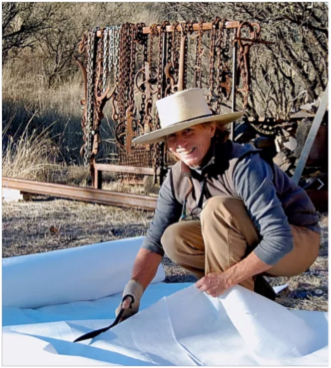 Kate Engaged in a Project
Kate Engaged in a Project
We build function into this system for our own practical use. Our cold storage, for example, becomes a discussion about appropriate building and how to minimize our energy needs for heating and cooling. We have a composting toilet that feeds an orchard with humanure. Water catchment, slowing the water down, hydrating soils, supporting the native vegetation that exists, minimizing or stopping the erosion that is going on, and starting to rebuild the system that is the foundation for supporting wildlife habitat. When you infiltrate more rainwater, you increase production of food, which attracts the wildlife in. When you attract them in, they come in to feast on the nectar and pollen and berries and seeds that are produced more abundantly in those places. They leave the gift of their body waste which is nutrients and invariably packed with seeds from other parts of the same watershed or the same landscape, and those seeds are then left in places that are more likely to be beneficial for germination and survival of more plants. So we are building in diversity, too, and the more diversity we have, the more resilience you have. We are working with the system, we’re lifting thing up rather than imposing on.
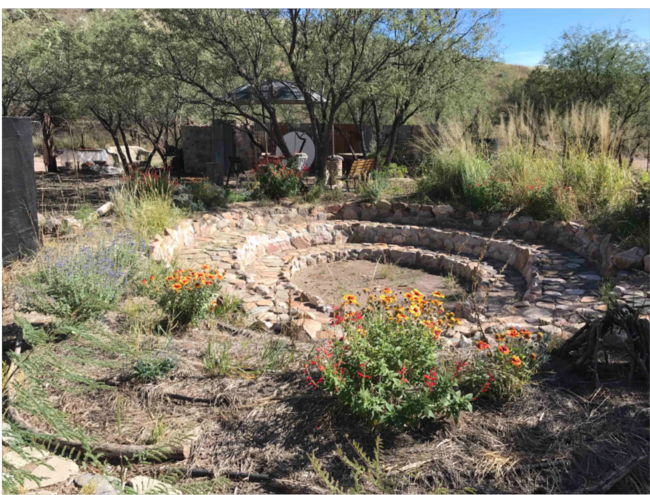 The Amphitheater
The Amphitheater
GG: As you were sitting with the land for those seven months did you journal or was it a combination of journaling and feeling things in your body?
KT: No journaling. Photographs. I am very visual and I have something like 36,000 photos and videos on my computer from this project. I began in the beginning with that but I would sit and stare at things. And sometimes there would be an image that surfaced and I would see where I wanted something to go, or a step forward. It is a very visual process but it is imbued with training. I spent a lot of time training in this field and training as an observer. I was fortunate to have a very wonderful mentor who is one of the most able readers of landscape that I have ever met.2
You learn to look for what has consistency, you look at the kind of plants to have an understanding of the underlying geology. You want to understand what historically has shaped the land into what it is and what continues to shape it over time and then to see what can be done to increase the life in that landscape. And for me that always begins with soil. Deep Dirt is the first place I haven’t actually had to make soil. And soil is, as one writer (eds’ note: William Bryant Logan) put it, “the ecstatic skin of the earth.”
GG: Aaaw, that is lovely!
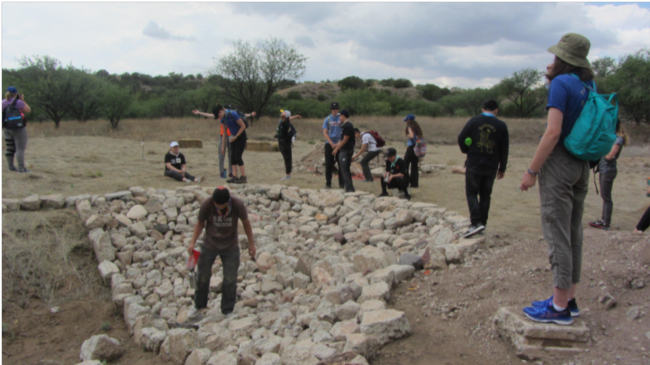 Volunteers Tending to Water Flow
Volunteers Tending to Water Flow
KT: Without soil—which is the medium between geology and biology—without soil and a place for plants to root and thrive, there is no atmosphere. So without the soil we wouldn’t be here. But soil now we are beginning to understand in a broader way is what captures carbon. It is where we hold a lot of that both in plant matter and also in the life in the soil itself and in the fungal systems that are there, because fungal systems are an incredible part of the life diversity in the soil. So creating conditions that increase that diversity is foundational and critical, especially now. Probably always has been, but we just haven’t recognized it. We have been very conventional about soil.
GG: We’ve been trained to think what’s foundational is the oxygen/carbon dioxide exchange with plants.
KT: Right. But living soil is a very special thing, and to do things to make the soil more alive—there is something incredibly pleasing about that [laughs softly]. MacKenzie, my intern, and I harvest the food we are growing in the garden without washing anything or our hands, and every time we do and our hands have some sort of soil on them and we look at each other we say: “Probiotic!” So just by increasing the life in the soil and then we get it our mouths and in our guts—that life gets moved into our bodies. We are just part of the hologram of the whole place. It’s an echo!
GG: And if you are not in that new language or paradigm, you wash and scrub and peel and sterilize your carrots and vegetables.
KT: And you pee in a toilet and you flush it. [laughs] Everything is designed to keep us clean and separate from all the things that we need actually to be healthy and to thrive.
GG: What were your communications with the land like? Did you feel they were internal to you or did you sense you were actually in conversation with an intelligence outside yourself?
KT: I don’t know that these things are separate, Gillian. Some of my experiences over my last twenty some years have been in the Amazon being in altered states in traditional shamanism. In one in particular, I experienced myself as a tree and it was as real to me as this conversation with you. I could feel the physicality of being a tree, the weight of soil on my roots, and it was comforting, comforting as the experience of being a child tucked into a warm bed by your mother. It’s a rootedness, right, an anchoring and a stability, and a stable feeling of belonging, and that feeling is so critical. I also had the sense of branching out into the—and I’m reaching out my arms as I am saying that… [laughs]
GG: Oh nice… [laughs with her]
KT: It is a physical thing, that sense of being branched out. I see you doing that! [Laughs]
GG: I am because the shamanic name given to me by a tree is “Mother Tree” …
KT: Oh, wow, how lovely! But what surprised me in that experience was becoming aware of how much life was supported in the fissures of my bark. In every crack and crevice of my being there was life. There were insects and plants and mosses, and everything that lives within the crevices of a tree. I’ve always had relationships with the trees since I can remember, spending lots of time in trees as a child growing up.
GG: So when you sat on the land so many years ago and you engaged with the trees, the plants, the soil, the movement of animals, you were perhaps already bringing to that conversation this experience of walking in the skin of a tree?
KT: Yes, yes, and I don’t know because of how and where I grew up, that I’ve ever been separate from it [the land]. I know that my mother early on—I was born in December— as soon as the weather was reasonable enough put me outside in a pram that was open to the weather so I could feel the touch of wind and moisture on my face. I have this memory of looking out at the sky and trees very, very early in my life. So I think those feelings began back that long ago. And growing up in a faery culture, which Wales is, the invisible part of the landscape was acknowledged early on as something alive and something part of every day. And I think that’s something we’ve lost: these connections and really that sense of belonging to each other and to the planet. So we say, “us and nature” rather than think of ourselves as within it and not separate.
GG: And in fact that is a very recent turn in our civilization. In the Middle Ages it was a much more dynamic world of magic, and faeries and shape shifting and connection…
KT: Yeah, yeah…
GG: The light that shone in the eyes of a person was the same light that shone in the stars in the night sky, for example. Connections like that. I’m really interested in hearing more from you about how you’ve experienced that separation of us and nature, how does that play out in your teaching at the Deep Dirt Institute and Campus?
KT: One of the things that is very hard to convey is the sense of what a watershed is—and in restoration work, we look at restoration from a watershed point of view. I like to begin with the image of taking a shower because that is such a familiar and personal space, how water lands on our head and because our head is fairly flat it divides all the way around and spills off in every directions but our noses are ridges and the water tends to go down each side with some dripping off the end, and it is true of your shoulder, too. Slopes and hillsides are like shoulders on the planet and the water does a similar thing when it lands on them. It goes to either side and spills into small watersheds where it pours down on those slopes and concentrates on the bottom in those particular landscapes.
And where we live you can’t really see our total watershed until you are actually flying above it and you can look down the pretty bare bones of this arid landscape and you can see patterns and flows in there that look like branching patterns of trees that are all watersheds within the larger watershed of the lower Colorado River. And I like to hold up a branch from our Mesquite tree—which is a very popular and common tree in our landscape—and that pattern is branching; it is how nutrients and fluids moves through the tree. But then if you think about what is within us that works like that, it’s our blood vessels, our nerve systems, our lungs, and our eyes, our kidneys, so when I look at that and I think about the branches, the roots, the watershed, the streams coming together into larger streams and rivers, it’s the same dendritic pattern that looks like what we have inside us. It tells me that we are not separate.
And so having simple tools like a branch with little twigs on it [chuckles], it tells a whole lot and it’s remarkable to me how quickly kids can follow and understand that we are not outside of this thing that we call nature.
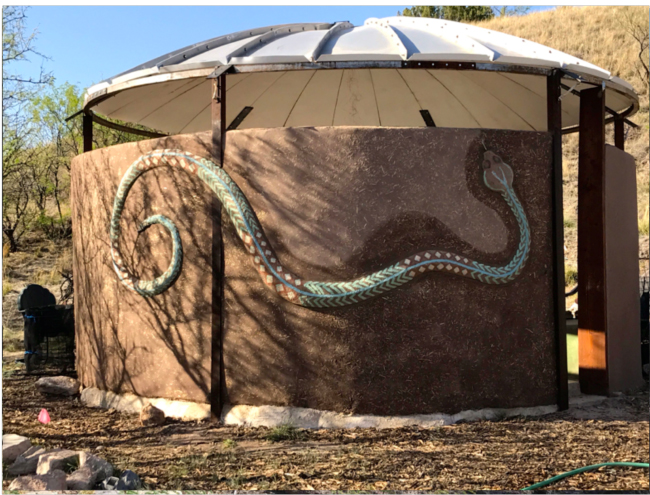 The Snake Gathering
The Snake Gathering
GG: Gregory Bateson used to talk about patterns that connect; he used to say our modern culture suffers from a failure of the imagination, because the kinds of patterns that we draw are not patterns that are intrinsic in things; they are patterns that link the abstract knowledge system in our heads to what we see…. How do you pass on not just the image but the actual felt-sense of that connection? Are there any other dimensions of this awareness that you strive to pass on to people?
KT: When we begin the day on our campus, after introductions, I ask everyone to look down and go inward and feel for the answer, then find words to articulate. The question is, what’s burning in your heart right now? And it could be anything from personal to global and whatever in between. It sort of brings us down to some heartful place, an emotionally connected space. We go out after that sharing. It’s invariably moving. And at the end of the day, I ask two questions: what are you taking away from today? That triggers what they’ve seen, and what they’ve heard, and what they’ve attended to, what might have caught their attention. Then I ask, what are they going to put into action to create a better future on the planet? And that is pretty fascinating to see in the young people in particular. Utilizing waste is a big piece of what we do on the site. We talk about not consuming as a huge component….
GG: I recall that most of the structures on your land are structures created with found objects, correct?
KT: With either waste or materials we have bought ourselves or a combination of both, like we’ll use our soil to make adobe bricks for building walls and then satellite dishes make great roofs, and then we use soil and rock on those to create insulation, and then grasses come in and they live on those roofs and then they’ll dry and they’ll come back with the seasons.
I want us to sort of pare ourselves down to the rudiments of life which is: this place that provides for everything that we need. And we must be in reciprocity not only because we are required to, but because it nurtures us as much as it nurtures the other, which is also us.
GG: “Reciprocity”—how does that flesh out in the day-to-day at the campus?
KT: I spent a lot of my own personal life on a healing journey from the blows of life that happen. And for me that has meant healing the place that I am responsible to. So slowing down water, slowing down erosion, letting damaged areas stabilize and rebuild through the processes that normally unfold, like flows of water, wind moving, the putting out of waste, like wood chip mulch on pathways. The most delightful part of that is the play of reciprocity! This fall we had beautiful rains late summer and late fall. They started late and they ran late and it was perfect for mycelium and under all those wood chip paths that we’ve been putting down for the last four years or so, mycelium popped out in so many places! I have been watching it increase over the last few years but this year the number and diversity of species was really profound. And for me that was really joy! It was like finding a faery ring when I was a child. The joy of those beautiful little life forms popping out of the wood mulch or in other places where we’ve been treating the soil with particular care. Or the increase in number of birds or snakes or how many more footprints of cloven-hooved animals—the javelina that are coming through, even though they are raiding some of the plants [laughs, Gillian with her]. First your heart can get sad—oh those animals, they just ate those plants that didn’t have more than a year in the ground! And then you say, well, part of what I am doing is increasing habitat and I’m encouraging them to come in. We have more water for them, we have more food for them. And then that becomes part of the pleasure of what we are doing.
So it’s all of that—there is a collective that we live in. An astonishing landscape of folded hills that have layers and layers of volcanic ash, which has a story I don’t fully understand; somebody else’s knowledge can change your relationship with a place. Recently that was our lead geologist for the USGS who has been over a few times lately. And every time he comes he has some wisdom and some story to tell about the formation of the landscape. As we stood on top of a ridge talking about soil and looking across at what I think of as the meadow, he said what you see there—that big flat area and that first ridge—is the first terrace above an ancient riverbed. I didn’t know that! And now I have a different imagining around how that piece came to be and why the soil there might be different than it is to the sides of that spot. So it’s not a static world at all, Gillian. It’s something that builds over time and because we have a lot of pretty interesting visitors, I’m gleaning constantly new pieces of the story that is unfolding under my feet and around me, and I can share that with young people or any of our guests, because I’m in this place of discovery still.
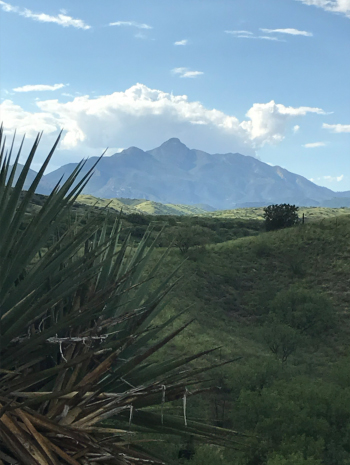 The Mountain
The Mountain
Just to be co-creators with this Earth of ours, whether it’s the size of your back porch, the trunk of your car, your garden, whatever that might be, or, well, we’re fortunate enough to have a thirty-four-acre chunk. But to imagine each of us taking care and tending our own little piece, and what that could do to fill in a whole mosaic, that we dream a new story for a new way of being on the earth.
GG: I’m curious to know: do you feel the land itself as a whole is talking back to you?
KT: I actually don’t feel outside of it. I feel I’m inside this place. I don’t have the sense of ownership. I do have a sense of belonging. It’s a dance that we’re in together. And I’m struck by the response of people regardless of age. It’s been transformative for so many people. I think that people can see and children can see and participate in something that is durable that will continue to function, to continually heal, to continually build life over time. I go out and look and I can see what is coming back to life because of what we’ve done. Just the other day I went to look around and see if any of the seeds we’d scattered or seed balls we’d put out had responded to rain. And I found a seed ball tucked by some rocks that had sprouted—a pretty big seed—and there it was in late December on a very cold day with the remnants of a seed ball around it sheltered by rocks. It’s that. That took me back to a memory a few years ago when I’d returned to Mexico and I didn’t have a place to stay that night, so I lay my sleeping bag out on the ground near the beach and just felt as safe and as protected and as belonging as I have ever felt, just being on what I felt in the moment as the breast of the mother, our mother planet. And the sense of being at home, just being at home there… I don’t know if I answered your question…
GG: Yes, you have. Completely! You keep coming back to there is no “and” between you and your land, and you and “the ecstatic skin of the Mother” and obviously in the questions I’m asking I’m betraying there is still a sense of separation for me, right, and it’s a sense of separation that my imagination wants to bridge but the actual flow of my day doesn’t support.
KT: Yes, I think we have it in cellular memory but there is so much stuff in our every day that gets in the way. It’s coming back home, literally coming back home to our mother, to that life which sustains us. And we absolutely need to bring people in as quickly and as concretely as possible to imagine a new story on the planet…
Photo credits: Courtesy of Deep Dirt Institute and Campus
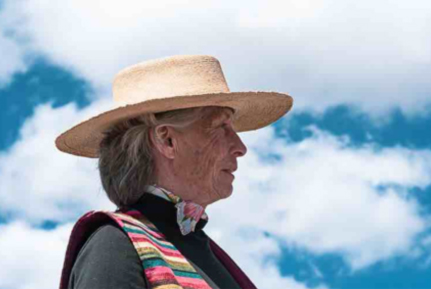
Kate Tirion grew up on a pre-industrial Amish style farm and flour mill in West Wales, UK, “where everything was made from scratch” and ”faeries were around.” After trying to grow plants in the desert in her twenties during a trying time in her life, Kate earned a Certification in Eco-Horticulture at the Center for AgroEcology and Sustainable Food Systems at the University of California at Santa Cruz and studied permaculture formally, becoming certified as a Designer. She founded Deep Dirt Farm, then Institute and Campus, with her partner Richard Connolly in 2005.
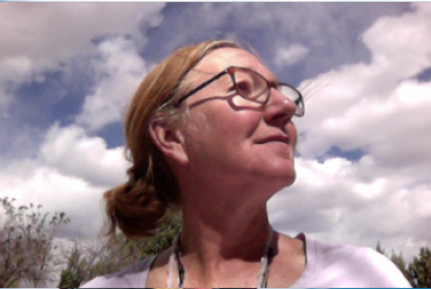
Gillian Marie Goslinga is a cultural anthropologist and feminist ethnographer by training. She resigned her academic career due to chronic Lyme and environmental illness in 2014, which proved to be an exhilarating initiation into realms of healing close to Mother Earth. She lives in the Verde Valley of Arizona with her horse Spirit and cat Shaba.
To comment on this article, please click here.
Copyright © 2014-2021 Dark Matter: Women Witnessing - All rights reserved to individual authors and artists.
Email: Editor@DarkMatterWomenWitnessing.com
Please report any problems with this site to webmaven@DarkMatterWomenWitnessing.com
